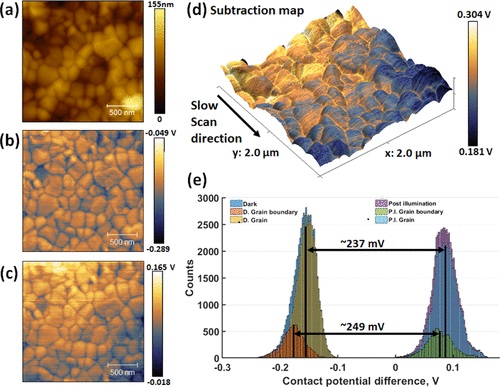Nanoscale investigations by scanning probe microscopy have provided major contributions to the rapid development of organic–inorganic halide perovskites (OIHP) as optoelectronic devices. Further improvement of device level properties requires a deeper understanding of the performance-limiting mechanisms such as ion migration, phase segregation, and their effects on charge extraction both at the nano- and macroscale.*
In the article “Nanoscale Charge Accumulation and Its Effect on Carrier Dynamics in Tri-cation Perovskite Structures” David Toth, Bekele Hailegnaw, Filipe Richheimer, Fernando A. Castro, Ferry Kienberger, Markus C. Scharber, Sebastian Wood and Georg Gramse describe how they studied the dynamic electrical response of Cs0.05(FA0.83MA0.17)0.95PbI3–xBrx perovskite structures by employing conventional and microsecond time-resolved open-loop Kelvin probe force microscopy (KPFM).*
Their results indicate strong negative charge carrier trapping upon illumination and very slow (>1 s) relaxation of charges at the grain boundaries. The fast electronic recombination and transport dynamics on the microsecond scale probed by time-resolved open-loop KPFM show diffusion of charge carriers toward grain boundaries and indicate locally higher recombination rates because of intrinsic compositional heterogeneity. The nanoscale electrostatic effects revealed are summarized in a collective model for mixed-halide CsFAMA. Results on multilayer solar cell structures draw direct relations between nanoscale ionic transport, charge accumulation, recombination properties, and the final device performance.*
The author’s findings extend the current understanding of complex charge carrier dynamics in stable multication OIHP structures.*
NANOSENSORS™ Platinum Silicide AFM Probes of the PtSi-CONT type (nominal resonance frequency 13 kHz, nominal force constant 0.2 N/m) were used for the measurements described in the research article cited above. *

Figure 3. from “Nanoscale Charge Accumulation and Its Effect on Carrier Dynamics in Tri-cation Perovskite Structures” by David Toth et al:
Initial dark and relaxed closed-loop KPFM analysis of CsFAMAPbBrI. (a) Topography channel plotting surface height. (b) KPFM image prior to light pulse plotting Vcpd. (c) KPFM image seconds after the light pulse plotting Vcpd. (d) 3D topography overlaid with the calculated ΔVcpd map. (e) Histograms of before and after Vcpd maps separated into grain and GB responses. The double arrows indicate the difference between the mean values of the distributions.
*David Toth, Bekele Hailegnaw, Filipe Richheimer, Fernando A. Castro, Ferry Kienberger, Markus C. Scharber, Sebastian Wood and Georg Gramse
Nanoscale Charge Accumulation and Its Effect on Carrier Dynamics in Tri-cation Perovskite Structures
ACS Appl. Mater. Interfaces 2020, 12, 42, 48057–48066
DOI: https://doi.org/10.1021/acsami.0c10641
Please follow this external link to read the full article: https://pubs.acs.org/doi/abs/10.1021/acsami.0c10641
Open Access The article “Nanoscale Charge Accumulation and Its Effect on Carrier Dynamics in Tri-cation Perovskite Structures” by David Toth, Bekele Hailegnaw, Filipe Richheimer, Fernando A. Castro, Ferry Kienberger, Markus C. Scharber, Sebastian Wood and Georg Gramse is licensed under a ACS AuthorChoice – Creative Commons Attribution 4.0 International License, which permits use, sharing, adaptation, distribution and reproduction in any medium or format, as long as you give appropriate credit to the original author(s) and the source, provide a link to the Creative Commons license, and indicate if changes were made. The images or other third party material in this article are included in the article’s Creative Commons license, unless indicated otherwise in a credit line to the material. If material is not included in the article’s Creative Commons license and your intended use is not permitted by statutory regulation or exceeds the permitted use, you will need to obtain permission directly from the copyright holder. To view a copy of this license, visit http://creativecommons.org/licenses/by/4.0/. Further permissions related to the material excerpted above should be directed to the ACS .